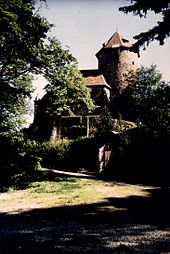Lichtenfels Castle (Lichtenfels)
| Lichtenfels Castle | ||
|---|---|---|
|
Aerial photo around 1998 |
||
| Alternative name (s): | Lechtenflens, Lechtenflins | |
| Creation time : | 1189/1223 and 1230 | |
| Castle type : | Hilltop castle | |
| Conservation status: | Received or received substantial parts | |
| Standing position : | Nobles, clergy | |
| Place: | Lichtenfels - Dalwigksthal | |
| Geographical location | 51 ° 8 '53 " N , 8 ° 48' 6" E | |
| Height: | 383 m above sea level NHN | |
|
|
||
The Burg Lichtenfels is a castle in the same named municipality Lichtenfels in Waldeck-Frankenberg in Hessen ( Germany ). It lies on a mountain spur above the village of Dalwigksthal and heralds the entry of the Orke tributary into Örksche Schweiz (Waldeckische Schweiz) from above .
Geographical location
The hilltop castle stands about 700 m east-southeast of the Lichtenfelser district of Dalwigksthal above the wooded and winding valley of the western Eder tributary Orke , which in Dalwigksthal is fed by the Wild Aa ("Aar"). It is located on the 383 m high northern foothills of the Eisenberg ( 432.4 m above sea level ).
history
Lichtenfels Castle was built as a hilltop castle in 1189 by the Corveyer Abbot Witukind von Spiegel zum Desenberg , shortly afterwards destroyed and rebuilt by Abbot Hermann I between 1223 and 1230 . On July 21, 1267, Corvey pledged the Lichtenfels Castle to Count Adolf I von Waldeck . After violent feuds, Corvey finally had to grant Count Otto I von Waldeck ownership of the castle in 1297 . The castle was then for a long time the seat of a branch of the Lords of Dalwigk , feudal men of the Counts of Waldeck.
A valley settlement with a church belonged to the castle in the Middle Ages . In the year 1598 there is talk of "Ensenbecke" and in the 14th century and at the end of the 18th century of "Eisenbeck". Today's village of Dalwigksthal was not built until 1851.
The archbishops of Cologne levied as Dukes of Westphalia repeated claim to lying in the Official Lichtenfels places Munden , Neukirchen and Rhadern , which resulted in the 16th and 17th centuries to lengthy processes and struggles. In the course of these disputes, the castle was probably destroyed again at the beginning of the 17th century. Partial reconstruction took place in 1631, and a more extensive one followed between 1908 and 1914.
Todays use
In the 1960s, the completely renovated castle was a recreation home for Anker-Werke from Bielefeld. At the end of the 1980s, the entrepreneur Tan Siekmann , founder of the Biodata company , and his parents bought the castle, which was again in need of repair, and extensively restored it, after which it was temporarily used as the company headquarters of Biodata , which went bankrupt in 2001 . Since 2004, the castle has been the seat of Safe-com , which is again managed by Siekmann .
literature
- Rudolf Knappe: Medieval castles in Hessen. 800 castles, castle ruins and fortifications. 3. Edition. Wartberg-Verlag, Gudensberg-Gleichen 2000, ISBN 3-86134-228-6 , p. 123.
- Rolf Müller (Ed.): Palaces, castles, old walls. Published by the Hessendienst der Staatskanzlei, Wiesbaden 1990, ISBN 3-89214-017-0 , pp. 234-236.
- Architectural and art monuments in the Eisenberg district , p. 37 f.
- Jens Friedhoff : The restoration of Lichtenfels Castle 1906-1914. Late historic castle renovation at the turn of the 19th and 20th centuries. In: Geschichtsblätter für Waldeck 93 (2005), pp. 76–97.
Web links
- Lichtenfels Castle, Lichtenfels municipality. Castles, palaces, mansions. In: Landesgeschichtliches Informationssystem Hessen (LAGIS).
- Lichtenfels Castle on castles and palaces




